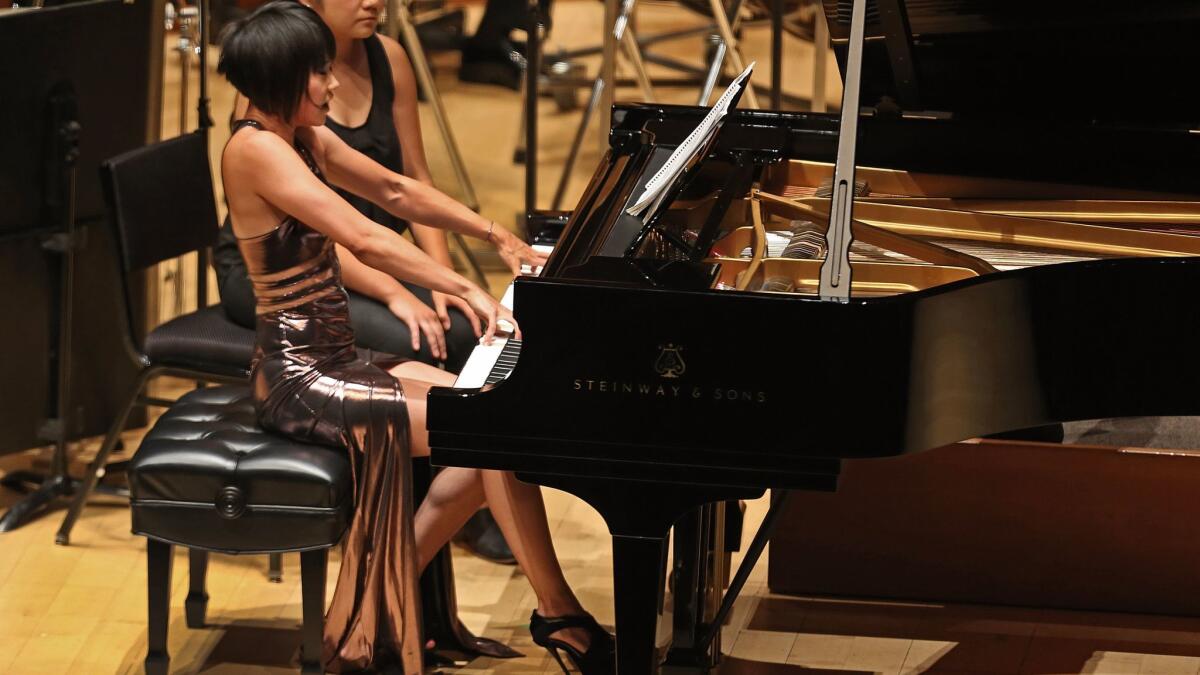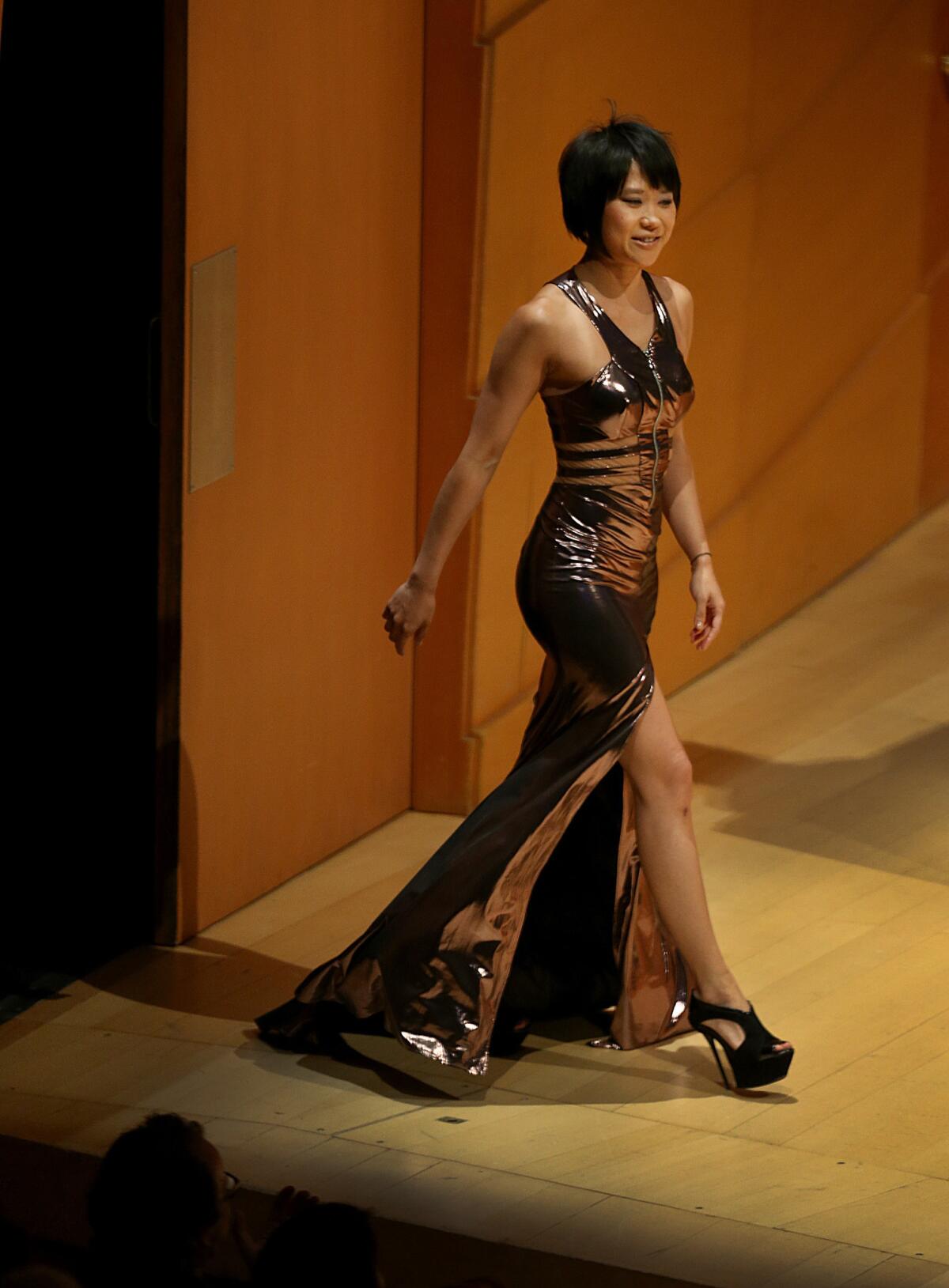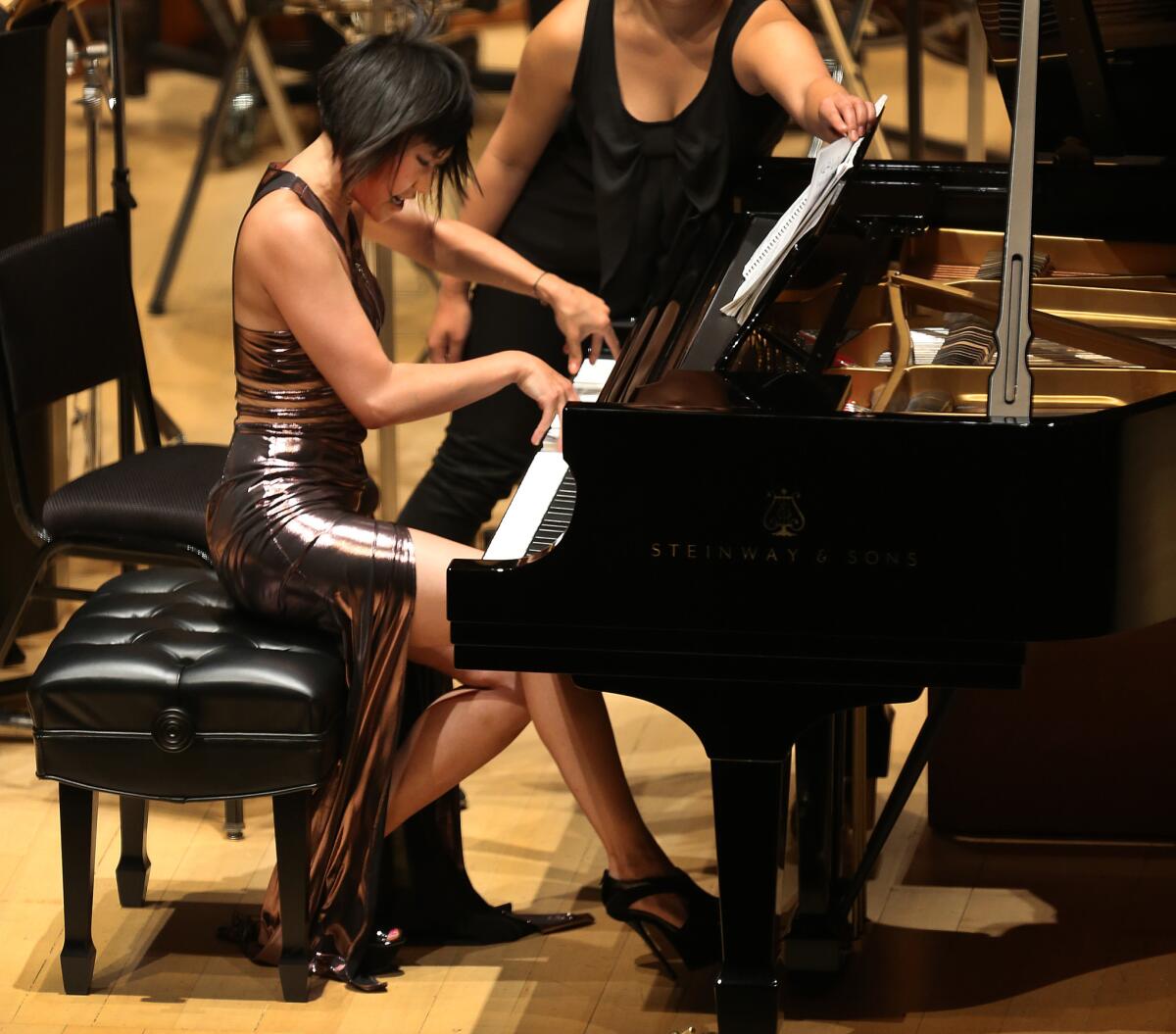Review: The draw of Yuja Wang and Bartók brings surprising consequences

- Share via
Yuja Wang dressed for the occasion Friday night, the beginning of her first cycle of Bartók’s three piano concertos. She wore a tight-fitting rose-gold metallic gown, boldly split up the middle.
She had come to

None of this, of course, was out of character for the Chinese pianist. The packed house would have been greatly disappointed by anything less, as it would have been had her phenomenal technique not been as striking as her look.
But something was, in fact, different this time as she joined the
She has spent the last couple of years jauntily piquing interest by proving, through a combination of stunning virtuosity and intent musicality, that she can create the startling juxtaposition of a flashy young star in stylish provocative dress while evoking the legendary piano gods of old playing warhorse concertos.
Here, however, her dress happened to be completely in character with Bartók’s concerto and the metallic, rhythmically tight way she played it. This is Bartók’s least lovable concerto. Barbaric is an adjective that comes to mind. The percussion section is very large, which for this performance was divided between the back of the orchestra and up front, with tam-tam and bass drum within touching distance of Wang.
There are two possible approaches. One is to try to keep pounding rhythms as clean and clear as possible. The other is to go with it and bang away.
Wang and Dudamel went for heavy lifting much of the time. But while she is a glittering percussive pianist, her tone has more in common with metal and skin percussion instruments (again just like her appearance) than wood. That meant she didn’t always cut through a thick orchestra, which sometimes in this score can sound as though it might be out to get her.

Even so, Wang’s motoric energy all but set a Frankenstein orchestra in motion, and her sheer élan provided motivation. Her races to the finish in the outer movements approached a human’s maximum digital velocity, leaving the band in near panic to keep up — and Dudamel exhilarated. In between, though, she found instances of girlish playfulness and, in the middle movement, even pianistic fragility, as a quiet and mysterious pulsating interplay between piano and the percussion section became all shimmer.
Yet for all this, the even greater ambition of the evening may have been the way in which Dudamel framed the concerto. He began with the severe fragility of Stravinsky’s last major work, “Requiem Canticles,” and ended with the massive power of Janácek’s “Glagolitic Mass,” both of which require a large orchestra and chorus, and both of which also operate through the original application of pulse.
Stravinsky and Janácek turned to these Masses at the end of their lives, and Stravinsky’s, written in L.A. in 1966, has the flavor of being his own requiem. The L.A. Phil first played it in 1970 under Zubin Mehta, who then added it to the program a year later when the news came that the composer had died.
Everything in this 14-minute requiem is pared down, including the Latin text. A full orchestra is indicated, but a small string section and a small chorus are typically all that are wanted, since most of Stravinsky’s lines are for solo or chamber-sized forces.

Dudamel used a big orchestra and a full
No modesty is to be found in the “Glagolitic Mass,” a weird and wonderful massive work for big orchestra, chorus, four vocal soloists and solo organ. The text is written in the ancient Slavic Glagolitic script, and that sets the tone, texture and catenation of Janácek’s effusive score, with its powerful brass reiterations, exuberant choral outbursts.
Four solo singers are expected to contribute operatic effusions, which Angela Meade, Alisa Kolosova, Ladislav Elgr and Stefan Kocan did. An extravagant solo organ movement, extravagantly played by Iveta Apkalna (who’d given a recital on the Disney organ a few days earlier), is additional craziness in an already magnificently crazy piece. Throughout, Dudamel marshaled his massed forces in the irresistible conviction that bigger is better and glory is around every corner.
Among the fascinating dialogues among the evening’s works was the fact that Janácek’s Mass was written in 1926, the same year as Bartók’s First Piano Concerto. It was revised in 1928, the year of Janácek’s death, making it, like “Requiem Canticles,” the composers’ departing religious rites.
There is something else. Stravinsky’s comments on “Requiem Canticles,” quoted in the program notes about the late condensation of style, could just as well describe Peter Brook’s late style (or, as Stravinsky says, his “last-ditch period”) in “Battlefield,” which was at the Wallis Annenberg Center for the Performing Arts in Beverly Hills last weekend.
“Battlefield,” moreover, is based on the Sanskrit epic “The Mahabharata,” which Brook treats as a profound meditation on war, and it so happens that Stravinsky gave special permission for the as-yet-unreleased first recording of “Requiem Canticles” to be played in 1967 at the funeral of Robert Oppenheimer, the father of the atom bomb, who was also a Sanskrit scholar and translated parts of the “The Mahabharata.”
There’s even more. What the L.A. Phil notes leave out are Stravinsky’s mordant quip about having been accused in his use of choral chant in “Requiem Canticles” of copying the crass musical score of “Marat-Sade,” which Brook directed two years before Stravinsky’s work.
The world, though, as “Battlefield” affirms, turns. Now, thanks to Dudamel and the L.A. Phil, “Requiem Canticles” can serve as more than a pivot to the brash earlier world of a Bartók who would mellow into the elegance and, finally, sage eloquence of his last two piano concertos, which Wang will play this week. Stravinsky’s late, great score can further serve as vivid reminder of just how prodigiously Brook’s wisdom has grown from “Marat-Sade” to “Battlefield.”
MORE CLASSICAL COVERAGE:
Interview: Yuja Wang on Bartók, teaching and Act 2 of her career
LACMA’s radical plans for how we see the permanent collection
At East West Players, the gut-wrenching emotion of 'Next to Normal' transcends race
The biggest entertainment stories
Get our big stories about Hollywood, film, television, music, arts, culture and more right in your inbox as soon as they publish.
You may occasionally receive promotional content from the Los Angeles Times.







